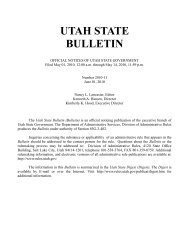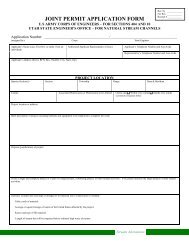Vol. 2007, No. 15 (08/01/2007) PDF - Administrative Rules - Utah.gov
Vol. 2007, No. 15 (08/01/2007) PDF - Administrative Rules - Utah.gov
Vol. 2007, No. 15 (08/01/2007) PDF - Administrative Rules - Utah.gov
You also want an ePaper? Increase the reach of your titles
YUMPU automatically turns print PDFs into web optimized ePapers that Google loves.
NOTICES OF PROPOSED RULES DAR File <strong>No</strong>. 3<strong>01</strong>80<br />
(b) A medical practitioner may repackage no more than one<br />
week's worth of a client's prescription medication into individual<br />
dose packages, each of which shall be labeled with the client's name,<br />
the name of the medication, and the time, date, and dosage that the<br />
medication is to be administered.<br />
(c) Individual dose packages shall be stored together with the<br />
original pharmacy packaging and pharmacy label, directions and<br />
warnings.<br />
(8) The staff-in-charge or a staff with documented training in<br />
medication procedures that is designated by the staff-in-charge shall:<br />
(a) administer or oversee the self-administration of prescription<br />
medications only as prescribed by a medical practitioner;<br />
(b) administer or oversee the self-administration of nonprescription<br />
medications only as directed by the manufacturer;<br />
(c) observe the client consume any medication;<br />
(d) maintain an individual client medication log, which shall<br />
include the client's name and photograph, medication, time and<br />
dosage administered, effects of the medication, and initial or<br />
signature of client and staff administering medication; and<br />
(e) immediately notify a client's physician of any reactions to<br />
medications that are severe or that are not expected according to<br />
warnings on prescription or non-prescription labels.<br />
(9) Each client medication log shall be maintained together<br />
with the medication while the client is actively enrolled in the<br />
program, and transferred to the client's file when the client leaves the<br />
program.<br />
(10) Upon discharge from a program, the program shall<br />
transfer a client's unused medications to the client's guardian or, if<br />
the client has no guardian, to the client.<br />
(11) Unused or expired medications shall be destroyed by two<br />
direct care staff, and the destruction shall be documented.<br />
(12)(a) A program shall inform the client's guardian of any<br />
emergency medical treatment no later than 48 hours after treatment<br />
commences.<br />
(b) Except for minor first aid treatment, a program shall obtain<br />
the prior written consent of the client's guardian for any nonemergency<br />
medical treatment, including the administration of<br />
medication not provided by the guardian.<br />
R5<strong>01</strong>-2-13. Infectious Disease.<br />
(1) The program shall have written policies and procedures<br />
designed to prevent, or control infectious and communicable<br />
diseases, including but not limited to AIDS, chickenpox, Gonorrhea,<br />
Hepatitis, HIV, Measles, Meningitis, Mumps, Rabies, Syphilis,<br />
Tuberculosis, or suspected or confirmed outbreaks of food-borne or<br />
water-borne disease in the facility in accordance with local, state and<br />
federal health standards.<br />
(a) The program shall immediately report any individual<br />
suffering from or suspected of having a disease that is infectious or<br />
communicable to the County Health Department in accordance with<br />
Section 26-6-6 and Rule R386-702.<br />
(2) A program shall develop written policies and procedures<br />
requiring the use of universal precautions to respond to incidents<br />
involving bodily fluids, which shall include proper clean-up<br />
procedures as recommended by the local health department.<br />
(3) The program shall provide universal precautions training to<br />
all staff and clients which shall include but is not limited to:<br />
(a) hand washing rules;<br />
(b) not permitting staff to work when sick;<br />
(c) sanitizing rooms utilized by sick staff or clients; and<br />
(d) procedures for limiting the exposure of healthy individuals<br />
to sick individuals.<br />
R5<strong>01</strong>-2-14. Emergency Plans.<br />
(1) The program shall have a written emergency response plan<br />
describing how staff shall respond in an emergency, including but<br />
not limited to severe weather, a fire, natural disaster, prolonged<br />
disruption of utility services, medical emergency, a client who may<br />
be missing, or significant criminal activity, to include:<br />
(a) designation of authority and staff assignments;<br />
(b) plan for evacuation, including but not limited to evacuation<br />
of persons who are non-ambulatory and persons with disabilities;<br />
(i) all staff and clients shall evacuate from a building within<br />
two minutes after an alarm; or<br />
(ii) all staff and clients in a program that is under exclusive<br />
contract with DSPD and provides services only to DSPD clients<br />
shall evacuate from a building in accordance with an emergency<br />
plan that has been approved in writing by an Office of Licensing<br />
Life Safety Inspector;<br />
(c) transportation and relocation of staff and clients, including<br />
but not limited to transportation and relocation of persons with<br />
disabilities;<br />
(d) location, supervision and care of clients after evacuation or<br />
relocation, including but not limited to care of persons with<br />
disabilities;<br />
(e) notification of each client's guardian; and<br />
(f) reporting significant criminal activity or medical<br />
emergencies to local law enforcement, emergency first responders,<br />
and the Office of Licensing.<br />
(2) The program shall comply with its approved emergency<br />
response plan.<br />
(3) The program shall educate staff and clients on how to<br />
respond to emergencies.<br />
(a) The program shall conduct quarterly emergency response<br />
drills, including fire drills.<br />
(b) The program director shall maintain a detailed written<br />
report for the Office of Licensing that assesses staff and client<br />
compliance with the program's written emergency response plan.<br />
(4) The program shall comply with the written safety<br />
requirements of the local fire department, including but not limited<br />
to requirements regarding emergency exits.<br />
R5<strong>01</strong>-2-<strong>15</strong>. Safety.<br />
(1)(a) The program shall provide staff and clients with<br />
emergency access to an operable telephone at all times.<br />
(b) Local emergency telephone numbers, including fire, police,<br />
poison control, emergency medical personnel, and other local<br />
emergency numbers, shall be visibly posted by each telephone.<br />
(c) On-call staff telephone numbers shall be immediately<br />
available to on-duty staff.<br />
(2) The program shall have a first-aid kit readily accessible<br />
within 100 feet of all on-duty staff.<br />
(a) The contents of each first-aid kit shall be as recommended<br />
by a nationally recognized program, such as the American Red<br />
Cross, or approved in writing by a medical practitioner.<br />
(b) The contents of each first-aid kit shall be inventoried and<br />
restocked within one week after each use, and no less than monthly.<br />
(c) First aid kits that include any medication shall be locked.<br />
(3) The program shall have at least one first-aid kit, one<br />
operational carbon monoxide detecting device, one operational<br />
40 UTAH STATE BULLETIN, August 1, <strong>2007</strong>, <strong>Vol</strong>. <strong>2007</strong>, <strong>No</strong>. <strong>15</strong>


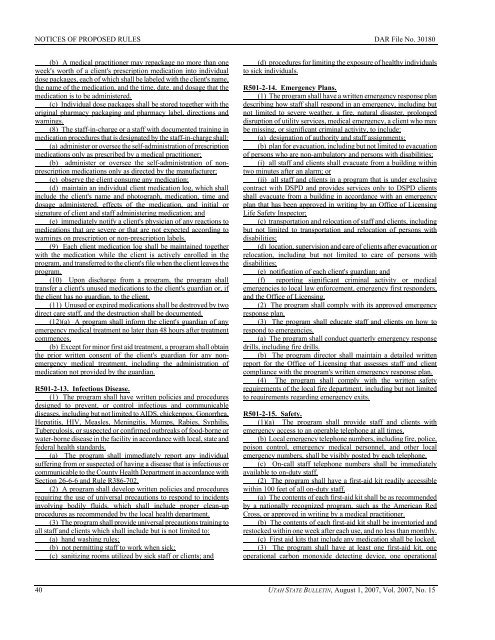


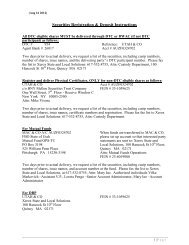
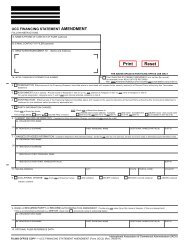
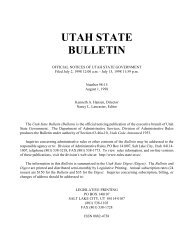
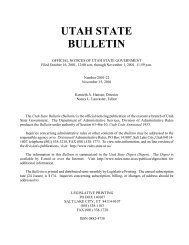

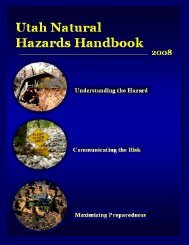

![Lynx avoidance [PDF] - Wisconsin Department of Natural Resources](https://img.yumpu.com/41279089/1/159x260/lynx-avoidance-pdf-wisconsin-department-of-natural-resources.jpg?quality=85)
